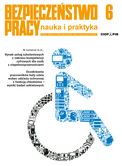The admissibility of right to refrain from performing work in healthcare facilities in the light of art. 210 of the labor code
mgr ŁUKASZ J. LATOSIŃSKI
The author discusses the regulation, which contains article 210 § 5 of the Labor code, especially concentrates on healthcare professionals. The article shows possibilities of usage § 5 to healthcare professionals. Further, the author shows the court rulings’ and jurisprudence’s position and also suggests change in the interpretation of the art. 210 § 5 provision regarding to healthcare professionals.
Previous position of court rulings and jurisprudence did not allow to restrain from work, or to leave the workplace by healthcare professionals, if health or life of the worker, or other people is in danger. COVID-19 epidemic experience asks to revise this position, what the author shows based on the arguments from the linguistic interpretation of the art. 210 from the Labor code. Some of the representatives of the jurisprudence, showed by the author, seem to agree with the argument described in the article.
Exposure to electromagnetic field during the use of fully electric or hybrid cars
dr hab. inż. KRZYSZTOF GRYZ , dr hab. inż. JOLANTA KARPOWICZ , dr hab. inż. PATRYK ZRADZIŃSKI , dr TOMASZ TOKARSKI , mgr ŁUKASZ KAPICA
The rapid development of e-mobility technology and the systematically increasing number of fully electric or hybrid cars does cause the increase in the number of electromagnetic field sources and electromagnetic emissions in the environment. The article presents the results of the recognition and evaluation of the exposure to electromagnetic field related to the use of fully electric or hybrid passenger cars in the context of literature data and own research.
The impact of sounds masking speech intelligibility on acoustic environment in open plan offices
dr hab. inż. WITOLD MIKULSKI
The article presents computational research results of the impact of the use of sounds masking speech intelligibility at workplaces located in typical open plan office areas. Four types of masking sounds at frequency spectrum and A-weighted sound pressure levels within the range of 25-45 dB were used. The criteria for the acoustic evaluation of open plan office rooms were adopted according to the EN ISO 3382-3: 2012 and the Polish standards: PN-B-02151-4: 2015 (room acoustic properties) and PN-B-02151-2: 2018 (background level, including masking sound). It has been shown that it is possible to obtain appropriate work environment conditions (including room acoustic properties) at the A-weighted sound pressure level of masking sound in the range of 31-37 dB (depending on the one of the four types of masking frequency spectrum considered).
High-speed frame camera in work environment – possibilities of application for measuring mechanical vibration
dr inż. PIOTR KOWALSKI , mgr inż. JACEK ZAJĄC
The article focuses on the possibility of the use of a high-speed frame camera to measure mechanical vibration in work environment. It presents the results of tests carried out on 11 hand tools related to the values of vibration accelerations measured with a standard measuring system based on piezoelectric vibration transducers. The differences obtained did not exceed 5.7%, which confirms the possibility of the use of a high-speed frame camera for testing hand-arm vibration. The article also draws attention to the limitations in the use of image analysis for vibration measurements resulting, among others, from the need for high optical zoom and ensuring stabilization of the camera position.





























